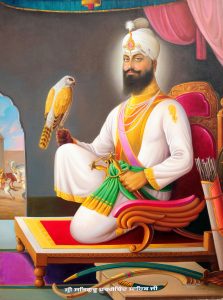
Guru Hargobind introduced the process of militarization to Sikhism, likely as a response to his father's execution and to protect the Sikh community.He symbolized it by wearing two swords, representing the dual concept of miri and piri (temporal power and spiritual authority). In front of the Harmandir Sahib in Amritsar, Guru Hargobind constructed the Akal Takht (the throne of the timeless one). The Akal Takht represents the highest seat of earthly authority of the Khalsa (the collective body of the Sikhs) today. On 25 May 1606 Guru Arjan, five days before his own death, selected his son Hargobind as his successor and instructed his son to start a military tradition to protect the Sikh people and always keep himself surrounded by armed Sikhs for protection. Shortly afterwards, Guru Arjan was arrested, tortured and killed by order of the Mughal Emperor Jahangir. Guru Hargobind's succession ceremony took place on 24 June 1606. He put on two swords: one indicated his spiritual authority (piri) and the other, his temporal authority (miri).He followed his martyred father's advice and always kept himself surrounded by armed Sikhs for protection. The number fifty-two was special in his life, and his retinue consisted of fifty-two armed men. He thus founded the military tradition in the Sikh faith. Guru Hargobind ji had three wives: Damodari, Nanaki, and Marvahi.He had children from three wives. Two of his eldest sons from the first wife died during his lifetime. Guru Tegh Bahadur, his son from Mata Nanaki, became the ninth Sikh Guru. The Sodhis of Anandpur Sahib are the descendants of Baba Suraj Mal Sodhi, one of Guru Hargobind's sons. The Guru was a martial artist (shastarvidyā) and he encouraged people to maintain physical fitness and keep their bodies ready for physical combat. He had his own Darbar (court). The arming and training of some of his devoted followers began. The Guru came to possess seven hundred horses and his Risaldari (army) grew to three hundred horsemen and sixty musketeers.
